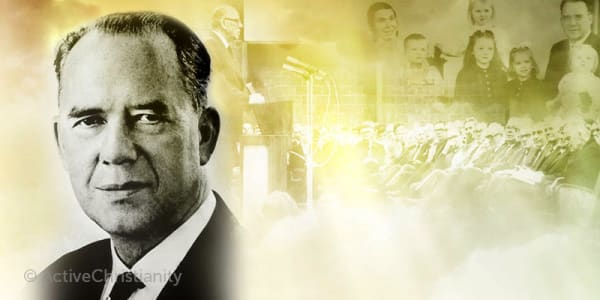Learn more about ActiveChristianity, or explore our theme pages for more

Aksel Johan Smith: “I and My Father are One”
Aksel Johan Smith was a man with great spiritual power, who devoted his entire life to God’s service.

Aksel Johan Smith
Aksel Johan Smith was an uncomplicated man who had great spiritual strength. He devoted his entire life to God’s service. His life stands as a shining example of faithfulness and in making full use out of life’s small and great situations.
Aksel J. Smith was born in Horten in 1910. He was the fourth child of Pauline and Johan Oscar Smith. Growing up in a Christian home with exceptionally God-fearing parents, he from a young age became convinced of the power of the gospel and that it is possible to live a life of freedom from sin. As a young man, he spent much of his time traveling to the different churches throughout Norway and as a missionary in Scandinavia. He also found time to complete trade school and become a cabinet maker. In 1930 he enlisted in the air force and fulfilled his military duty the following year. His love of country and patriotism never diminished throughout his long life.
“Hidden Treasures”
In January 1943, Johan O. Smith turned over the responsibility of editor for the church publication, “Skjulte Skatter” (“Hidden Treasures”) to his son Aksel. Aksel was 33 at the time. This was an unpaid position that depended on volunteer work, and in those days all editing and addressing all had to be done by hand. In 1947 Aksel married his childhood friend Ida Olsen. After this, they shared the tasks of editing and distribution of the hundreds, and eventually thousands of copies. They ensured that the articles not only were grammatically error-free, but also that they were doctrinally correct, edifying, and written in the spirit of faith in victory. Aksel and Ida never viewed this time-consuming task as a burdensome obligation, but rather as a privilege and joy. As their five children grew, they also helped in the extensive work. Aksel was editor in chief for “Skjulte Skatter” for 55 years.
Like what you’re reading?
Care for the church
Sigurd Bratlie, Elias Aslaksen, and Aksel J. Smith shared the responsibility for the church’s physical and spiritual development from the 1930s. Aksel fulfilled this ministry faithfully through some of the most tumultuous times the world has seen. A man of vision, he understood and had insight into what direction would be good for the church to develop.
Care for the church and for individuals was for Aksel a personal matter of the heart. He was a wise guide and leader. For example when there were legalistic rumblings regarding the woman’s place in the church, Aksel J. Smith followed in his father’s footsteps. He affirmed and upheld J. O. Smith’s stance that both women and men can serve in the church, and that women just as much so as men can contribute to the church community.
Aksel never sought his own interests, nor did he try to make a name for himself or become prominent through his ministry, although he easily could have done so on account of being Johan O. Smith’s son. But Aksel was completely uninterested in establishing a “spiritual elite.” Instead, he developed the rare ability to uplift his coworkers so that they contributed and felt valued.
Unreserved love
Aksel J. Smith’s life was based solidly on hidden sacrifice and serving God, the church, his family, and his community. As the church developed over three-quarters of a century during the difficult war years, then with international expansion in the 1950s and 60s, and thereafter, during the revival that came in the 1990s, Aksel J. Smith continued through all these times as a good, insightful, and meek shepherd for the church.
After his death in August 1998, it became even clearer what an inheritance he had left: an open, accessible, and international church. Aksel J. Smith understood what it meant to live faithfully in the here and now.
He was an active and involved participant in his local community in Horten, where he often visited the sick and elderly. Friends and neighbors from the city knew him as a man who not only spoke about Christianity, but who put Christianity into practice every day.
“I and My Father are one”
A fundamental aspect of Aksel’s life was his unreserved love toward everyone he met. He lived a life of complete faithfulness to the gospel of victory over sin and stood in such an uninterrupted inner development, that when he, toward the end of his life, read from John 10:30 at the BCC Easter conference in 1995, there was no doubt that this had become his personal testimony: “I and My Father are one.”
(Source: Bratli, Kjell Arne, En Herrens Hyrde: Aksel J. Smith 1919-1998, Skjulte Skatters Forlag 2007)
Scripture taken from the New King James Version®, unless otherwise specified. Copyright © 1982 by Thomas Nelson. Used by permission. All rights reserved.



